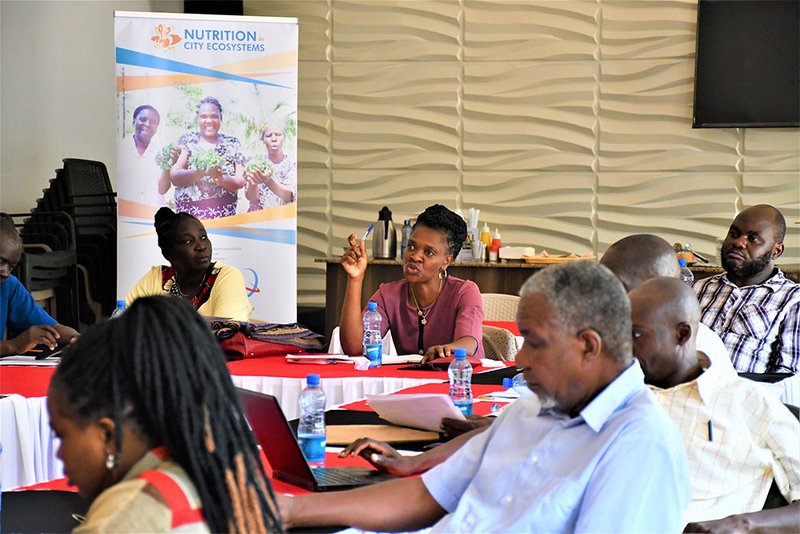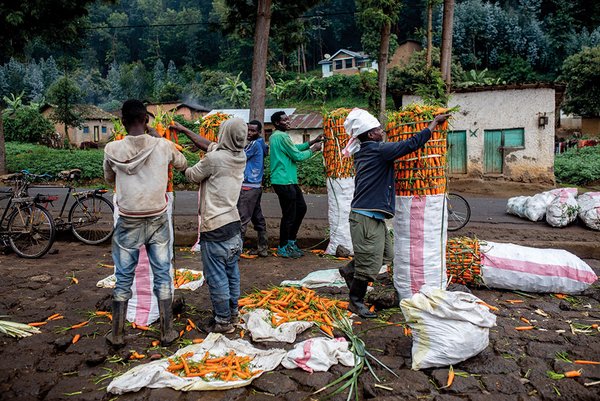 Download this article in magazine layout
Download this article in magazine layout
- Share this article
- Subscribe to our newsletter
Leveraging the potential of secondary cities
More than half of the global population now live in urban areas. Urban diets are influenced by factors such as changes in occupation, food marketing and societal norms favouring convenience foods and processed foods over traditional diets. High food prices and income constraints are making healthy diets unaffordable for three billion people. Poor infrastructure and long distances between rural agricultural areas and cities also exacerbate food losses and food safety concerns.
But urbanisation is not just about 'mega-cities'; it is also spawning smaller urban areas, known as secondary cities. In 2018, close to half of the world's urban residents lived in settlements or towns with less than 500,000 inhabitants. These cities are the fastest-growing urban areas. Compared to primary cities, secondary cities are typically smaller, closer to rural regions, and in areas where power is decentralised. With their strong urban-rural linkages and potential for localised food production, they play a critical role in sustainable economic and social development and offer unique opportunities to transform food systems for better human and planetary health.
In low-and middle-income countries, a substantial share of the population in secondary cities engage in gardening or farming activities. Farmers in these agricultural hinterlands play a vital role in supplying food, thereby bolstering the resilience of food security in these regions. These connections can also shorten food supply chains, fostering local development and promoting producer-consumer information sharing.
Secondary cities often fall short in economic and political stature compared to capital cities, and this lack of prominence can result in challenges related to infrastructure, governance, autonomy and decision-making capabilities. Yet these difficulties and systemic gaps can be transformed into valuable opportunities for enhancing the food system within these cities – most notably because their size means that the foodshed is relatively close to their urban centres and the consumers living there. For instance, human capital tends to be concentrated more in capital cities, creating a centralisation of power and skills.
However, initiatives like empowering local authorities and transferring knowledge from capital cities to secondary ones can address these issues by providing training and increasing educational opportunities for young people in smaller cities, especially in areas such as urban planning, agriculture and health. Moreover, secondary cities can leverage the skills and knowledge brought by individuals migrating from rural areas. By creating an environment that encourages the integration of rural expertise into urban agricultural practices, these cities can empower rural migrants, preserve traditions and transfer knowledge to the urban population. This approach can also serve to strengthen the links between farmers and urban markets, promoting sustainable collaboration, production and supply.
The NICE project
It is precisely this potential which the Nutrition in City Ecosystems (NICE) project (see Box at the end of the article) wants to raise. Initiated in 2021, it seeks to foster a more sustainable food system across six secondary cities in Bangladesh, Kenya and Rwanda. By augmenting both the production and consumption of nutritious foods aligning with agroecological principles, the project aims to enhance nutrition and alleviate poverty. In the targeted six cities, NICE conducted a baseline survey among over 1,200 households aimed at understanding the nutritional and socioeconomic conditions, agricultural practices within the city's food-producing zones, as well as residents’ food purchasing and preparation habits.
Results showed a substantial increase in food insecurity during the Covid-19 pandemic. Under-5 stunting rates were high, ranging from 9.1 per cent in Busia/Kenya up to 49.4 per cent in Rubavu/Rwanda, while around half of adult women are overweight (between 40.8 per cent in Rusizi/Rwanda and 50.6 per cent in Bungoma/Kenya). Furthermore, many women did not consume an adequately diverse diet in all three countries (Minimum Dietary Diversity-Women/MDD-W is <5 for 29.3 %, 47.5 %, and 67.0 % respectively), even though many of the urban and peri-urban households owned farmland. The main challenges revealed by the survey were the high prevalence of food insecurity and malnutrition. As a large majority of the dwellers have access to micro- and small farming in the urban and sub-urban area, there are options to improve the knowledge and skills of farmers through trainings and to facilitate urban markets to increase access to more fresh and healthy food.
Based on a multi-participatory process with farmers, local authorities, civil society and the private sector, five to nine value chains were selected for improvement in each country:
- Bangladesh: brinjal, bitter gourd, sweet gourd, cucumber, tomato, drumstick, zinc-enriched rice, mango, eggs.
- Kenya: poultry, African leafy vegetables (spider plant, black nightshade), groundnuts, fish (Tilapia), orange-flesh sweet potato.
- Rwanda: eggs, fish, carrots, onions, cabbages, passion fruits, tomatoes.
In addition, over 170 Farmers' Hubs have been established across the three countries. These hubs serve as centres for training in agroecological practices and coaching in business models. Moreover, social marketing campaigns have been elaborated which have reached over 60,000 farmers and consumers through school and health settings, Farmers’ Hubs and open market activations. The social marketing strategy aimed to build awareness about dietary diversity and agroecological farming practices. The open market activations consisted of a community roadshow wherein the production and consumption of nutritious and agroecological produced foods were incentivised in a common market ground. These were aimed at pregnant and lactating women and their husbands, mothers with at least one child under five years and their husbands, adolescents and their parents, and farmers.
One of the focus areas of the project is facilitating both horizontal and vertical knowledge exchanges to increase the production of agroecologically-produced foods and drive economic growth and empowerment across cities. While no new policies have been deployed in the cities so far, we have reviewed existing food system-relevant policies across the three countries. In the context of the NICE project, each city created a Multisectoral Food System Platform (MSP) fostering connection with local authorities and stakeholders, consolidating city priorities and jointly formulating strategies. MSPs also facilitate knowledge exchange with youth, women, farmers, civil society and the private sector to align their objectives. In addition, they put in place mechanisms for small grants to improve vulnerable inhabitants' access to more diverse diets.
In collaboration with city authorities, MSPs meet regularly, are engaged in capacity building activities to progress the food system agenda and are working to formalise their mandates as part of city regulations or bylaws. For example, in Rwanda, the NICE project has assisted in formulating and executing the Districts Plan to Eliminate Malnutrition (DPEM). In the following year, we will conduct public procurement assessments to expand farmers' outreach through channels that go beyond local open markets. Furthermore, the availability of the selected value chains in the urban market is to be improved by employing branded food carts and promoting the consumption of these selected foods through a social marketing campaign.

A food system multisectoral platform meeting with Busia County, Kenya. Photo: Syngenta Foundation for Sustainable agriculture/ Annette Wachira
Key learnings and future ambitions
Following the first two years of running the project, some key learnings can be stated. Primarily, it became clear that the project should focus on supporting local actors as they are best positioned to identify and enact impactful interventions in their cities. Furthermore, nurturing the leadership capabilities of these cities and fostering ownership is crucial to sustain and maintain the mechanisms that have been put in place.
Insights and actions from all parties need to be combined at different value chain points. It is therefore important to factor in the consumer and farmers' perspective from the beginning, for example, by increasing the market availability of local foods. Nevertheless, linking the production and demand generation sides has been challenging. This largely relates to timing and synchronising the work to ramp up the production of the selected value chains, in tandem with preparing the Social and Behaviour Change campaigns to firstly raise consumer awareness about the importance of nutrition and, secondly, to market the produce.
Now that the production and supply activities start to come together, we are looking more concretely into the link to markets and how to shorten the value chains. Moreover, small and medium enterprises (SMEs) and entrepreneurs are being engaged in the aggregation and processing of the food products. The MSPs are being expanded to bring in the private sector and representatives of consumer groups and civil society. MSP interactions bring different expertise together to address pressing issues related to nutrition and food security and tackle challenges such as climate change effects or price increases of imported goods. As production increases and becomes sustainable, possibilities are being explored for the produce from the Farmers' Hubs to be channelled to public institutions such as schools and hospitals.
In terms of knowledge and demand, there will be city-wide activities, involving youth through schools and colleges and community-resource persons like health workers and teachers. The social marketing campaigns will start to encourage aspects such as healthy cooking and purchasing practices to improve dietary diversity among consumers and stimulate demand for a range of nutritious and agroecologically produced foods to be made increasingly available and affordable by the project’s supply-side activities.
Furthermore, the insights gained are being used to shape city-level policies and contribute to showcase local initiatives meriting dissemination to national-level institutions in NICE countries, as well as broader city-region networks. Our aim is to drive an impactful, positive change in the city-region food systems by tapping into the potential of secondary cities. However, significant investments and concerted efforts are needed to empower such cities and enhance their capabilities to keep food system transformation high on their political agendas.
The Nutrition in City Ecosystems (NICE) project is supported by the Swiss Agency for Development and Cooperation (SDC). It is implemented and co-financed by a public-private Swiss consortium comprising the Swiss Tropical and Public Health Institute (Swiss TPH), ETH Zürich, the Sight and Life Foundation and the Syngenta Foundation for Sustainable Agriculture.
More information: https://nice.ethz.ch
Kesso Gabrielle van Zutphen-Küffer is the Director of Science at Sight and Life Foundation in Basel, Switzerland.
Jimena Monroy Gómez is the Technical Nutrition Associate at Sight and Life Foundation.
Helen Prytherch is Head of the Systems Strengthening & Health Promotion Unit at the Swiss Tropical and Public Health Institute.
Dominique Barjolle is a Senior Researcher and Lecturer at the Department of Environmental Systems Science of the Institute for Agricultural Sciences "Sustainable Agroecosystems group" at ETH Zurich, Switzerland.
Contact: kesso.vanzutphen@sightandlife.org
The authors acknowledge the leadership of the six NICE cities, the multisectoral food system platform members, and the NICE project staff in each country.
References & further reading:
de Bruin S, Dengerink J, van Vliet J. Urbanisation as driver of food system transformation and opportunities for rural livelihoods. Food Secur. 2021;13(4):781–98.
Pieterse DE, Parnell S. Africa's urban revolution. Zed Books Ltd, London; 2014
Secondary Cities as Catalysts for Nutritious Diets in Low- and Middle-Income Countries | SpringerLink [Internet]. [cited 2023 Jun 29]. Available from: https://link.springer.com/chapter/10.1007/978-3-031-15703-5_16
Speich C, Barth-Jaeggi T, Musard C, Havugimana C, Nwokoro C, Gakuba E, et al. Nutrition in City Ecosystems (NICE): Protocol of a multisectoral development project to improve food and nutrition security of secondary city populations in Bangladesh, Kenya and Rwanda. Frontiers in Public Health [Internet]. 2023 [cited 2023 Jun 29];11. Available from: https://www.frontiersin.org/articles/10.3389/fpubh.2023.1081535
United Nations. Department of Economic and Social Affairs (UNDESA). Migration, Urbanization and the Family Dimension. 2022. Available from: https://social.desa.un.org/sites/default/files/inline-files/Migration-Urbanization-and-the-Family-Dimension-by-Bahira-Trask%20%281%29.pdf




